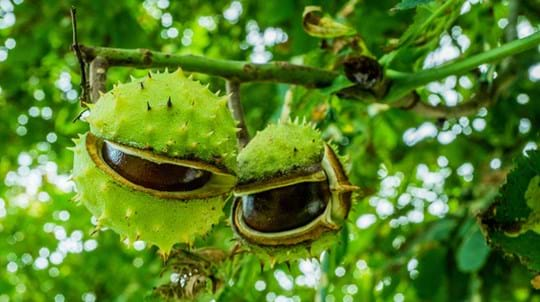
Blog
Do conkers keep spiders away? And other conker facts and uses
Rachel Hoskins • 30 Aug 2019

Content manager
The thrill of finding a gleaming conker is one of the many joys of autumn, for children and adults alike!
The traditional game of conkers was first recorded on the Isle of Wight in 1848. Since then, generations of youngsters have eagerly awaited conker season when they can hunt for worthy contenders to take into battle. Here, we’ll tell you when conkers are ready for collecting and give you some pointers to help you win your conkers games.
Conkers are the seeds of the horse chestnut tree. This attractive tree was brought to Britain from south-east Europe 400 years ago and became popular with landscape gardeners who planted them in the grounds of stately homes. Today, you can find horse chestnut trees in parks, gardens, streets and village greens across the UK.
In some areas, conkers are called cheggers, cheesers (flat-sided ones) and obblyonkers!
Conkers ripen in autumn and fall to the ground during September and October. Look for them scattered around the base of horse chestnut trees. The prickly outer cases will often burst open revealing the shiny, brown seeds inside.
If you’re collecting for a game of conkers, it’s best to gather ripe ones from the ground. Conkers attached to trees might not be ready and could still be soft in the middle – not good for a conker fight.
Did you know? Spotting your first ripe conker is important for science! We gather records of the changing seasons to track the effects of climate change on trees and wildlife. Discover how your family can help us on our Nature's Calendar website.
To be a conker champion, you’ll need a nut that’s tough to crack! In fact, it’s worth gathering a handful so you have some spares.
Look for freshly fallen conkers that don’t have splits, dents or soft spots – the harder and rounder the better. To check for duds, place your conkers in a bowl of water. The best ones will sink, showing they’re solid and firm.
True conker enthusiasts say it’s cheating to harden conkers artificially. But if you’re looking to give your conkers a boost before going into battle, there are plenty of tricks you can try:
Before you start playing, you’ll need to thread your conkers onto string. With an adult’s help, carefully make a clean hole through the middle of each conker using a skewer or screwdriver. Cut pieces of string about 50cm long and thread them through the holes. Tie a knot at both ends of the string so the conkers don’t fall off.
The World Conker Championships are held in Northampton every October. Thousands of spectators gather to watch the tournament, with players coming from across the globe!
Conkers is a game for two players, each with their own conker. Toss a coin to see who strikes first.
A new conker is called a ‘none-er’ and when it wins its first fight it becomes a ‘one-er’. If it beats another, it becomes a ‘two-er’ and so on. In some areas, winning conkers gain the points of the losing conker. So if a ‘two-er’ beats a ‘six-er’, it wins a point for the victory plus the six points from the conker it beat, making it a ‘nine-er’.
Whether you collect them, count them, or craft with them, there are endless ways kids can enjoy conkers.
A conker collection is a joy in itself and you can have lots of fun going on conker hunts, displaying your treasured finds and swapping them with others. Conkers also make marvellous maths aids – counting, sorting and weighing is much more interesting when you can get hands-on. And budding artists can use them to make natural sculptures, models or paintings.